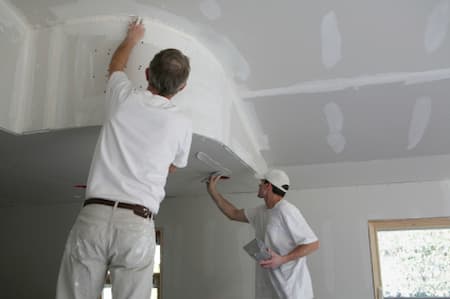Professional Sheetrock Repair Fort Worth for Quick Fixes
Professional Sheetrock Repair Fort Worth for Quick Fixes
Blog Article
Drywall Installment Facilitated: Tips for Perfect Outcomes
Drywall setup is often viewed as a daunting job, yet with the right approach and knowledge, it can come to be a manageable undertaking. Grasping techniques for reducing, hanging, and finishing drywall can considerably influence the end result.
Selecting the Right Materials
Choosing the proper materials for drywall installment is essential to achieving a durable and aesthetically pleasing coating. drywall fort worth. The primary part, drywall sheets, normally come in various densities, with 1/2-inch sheets being common for interior walls. For areas requiring additional moisture resistance, such as washrooms or kitchens, consider using environment-friendly board or concrete board, which are specifically made to endure humidity

In addition, picking the best fasteners-- either screws or nails-- is crucial for safeguarding the drywall to the framing. Drywall screws are generally favored for their holding power and decreased risk of standing out. Finally, consider the complements such as guide and paint, which not just improve the look however also protect the drywall from moisture and wear.
Preparing the Installment Area
Before beginning the drywall setup process, it is important to prepare the installment area completely. This preparation includes a number of crucial actions to ensure a smooth and successful project. First, clear the location of any furniture, devices, or blockages that might prevent access. A clean workspace lessens the risk of damage to existing products and enables reliable activity during setup.
Following, check the wall surfaces and ceiling for any type of flaws, such as fractures, holes, or mold. Address these concerns ahead of time; patch any damages and allow adequate time for fixings to completely dry. Additionally, guarantee that electric outlets, buttons, and plumbing are properly positioned and represented, as this will certainly affect drywall placement.
Take into consideration the ecological conditions. A stable temperature and moisture level are crucial for optimal attachment and efficiency of the drywall products. If needed, use a dehumidifier or heating unit to produce ideal problems.
Cutting and Hanging Drywall
The secret to reliable drywall setup lies in the exact cutting and dangling of the panels. Begin by measuring the area properly, taking into account any obstructions such as electric outlets or home windows. Utilize a straight side and an utility blade to rack up the drywall along your dimensions, after that snap it along the racked up line for a tidy break. For more elaborate cuts, such as around electrical outlets, a drywall saw can be made use of for precision.

Constantly function from the top down and left to right, making certain that you maintain a staggered pattern to enhance security. Effectively hanging the drywall establishes the structure for a smooth finish, eventually causing superior lead to your drywall job.
Insulation and Mudding Methods
While proper cutting and hanging of drywall establishes the stage, the next important step involves grasping taping and mudding techniques to guarantee a seamless surface. Taping is essential for strengthening joints and preventing cracks; it entails installing tape into the applied joint substance (mud) Beginning with a high quality fiberglass or paper tape, applying the tape over the joint and pressing it into the damp mud making use of a taping knife, making certain no air bubbles remain.
Once the tape remains in area, use a thin layer of joint compound over the tape, feathering the edges to create a smooth transition to the drywall surface area. Allow this layer to completely dry entirely prior to sanding it lightly to remove flaws. Repeat this process, using additional layers of mud as needed-- generally 2 to 3 layers-- while progressively expanding the application area with each layer to accomplish a seamless look.
After the final layer dries, sand the surface area with a fine-grit sandpaper until smooth. drywall contractor. Bear in mind to put on a mask during fining sand to prevent inhaling dust fragments. Understanding these taping and mudding techniques is critical for attaining a professional-quality finish in your drywall click this site installment
Finishing Touches for Perfection
Achieving a flawless drywall installment surpasses taping and mudding; it finishes in the completing touches that boost the overall look. These last actions are vital in making sure a professional-grade finish that enhances the aesthetic appeals of your area.
Begin by sanding the dried out joint substance to develop a smooth surface. Utilize a fine-grit sandpaper and a sanding block or post sander for optimal control. Pay particular focus to edges and corners, as these locations often tend to need even more thorough work. After sanding, clean down the wall surfaces with a try this website moist towel to get rid of any type of dust fragments, making certain a tidy surface for paint.
Following, use a guide especially made for drywall. This action is essential, as it assists secure the joint compound and supplies a consistent base for the overcoat. Once the guide dries out, evaluate for any imperfections, and retouch as required.
Verdict
In final thought, effective drywall installment hinges on the mindful selection of products, detailed prep work of the installation location, and exact execution of reducing and hanging techniques. Mastery of taping and mudding processes is essential for attaining a smooth finish.
Drywall installation is frequently regarded as a challenging task, yet with the best technique and expertise, it can become additional info a workable undertaking.Selecting the proper materials for drywall installation is essential to accomplishing a long lasting and cosmetically pleasing finish.Before starting the drywall setup process, it is important to prepare the installment area thoroughly. Understanding these taping and mudding techniques is vital for achieving a professional-quality finish in your drywall setup.
In final thought, successful drywall installation hinges on the cautious option of products, comprehensive preparation of the installation location, and precise execution of cutting and hanging techniques.
Report this page